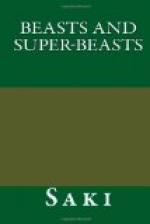As regards Knopfschrank’s work, they did not lack opportunity for inspecting and appraising it. However resolutely he might hold himself aloof from the social life of his restaurant acquaintances, he was not minded to hide his artistic performances from their inquiring gaze. Every evening, or nearly every evening, at about seven o’clock, he would make his appearance, sit himself down at his accustomed table, throw a bulky black portfolio on to the chair opposite him, nod round indiscriminately at his fellow-guests, and commence the serious business of eating and drinking. When the coffee stage was reached he would light a cigarette, draw the portfolio over to him, and begin to rummage among its contents. With slow deliberation he would select a few of his more recent studies and sketches, and silently pass them round from table to table, paying especial attention to any new diners who might be present. On the back of each sketch was marked in plain figures the announcement “Price ten shillings.”
If his work was not obviously stamped with the hall-mark of genius, at any rate it was remarkable for its choice of an unusual and unvarying theme. His pictures always represented some well-known street or public place in London, fallen into decay and denuded of its human population, in the place of which there roamed a wild fauna, which, from its wealth of exotic species, must have originally escaped from Zoological Gardens and travelling beast shows. “Giraffes drinking at the fountain pools, Trafalgar Square,” was one of the most notable and characteristic of his studies, while even more sensational was the gruesome picture of “Vultures attacking dying camel in Upper Berkeley Street.” There were also photographs of the large canvas on which he had been engaged for some months, and which he was now endeavouring to sell to some enterprising dealer or adventurous amateur. The subject was “Hyaenas asleep in Euston Station,” a composition that left nothing to be desired in the way of suggesting unfathomed depths of desolation.
“Of course it may be immensely clever, it may be something epoch-making in the realm of art,” said Sylvia Strubble to her own particular circle of listeners, “but, on the other hand, it may be merely mad. One mustn’t pay too much attention to the commercial aspect of the case, of course, but still, if some dealer would make a bid for that hyaena picture, or even for some of the sketches, we should know better how to place the man and his work.”
“We may all be cursing ourselves one of these days,” said Mrs. Nougat-Jones, “for not having bought up his entire portfolio of sketches. At the same time, when there is so much real talent going about, one does not feel like planking down ten shillings for what looks like a bit of whimsical oddity. Now that picture that he showed us last week, ’Sand-grouse roosting on the Albert Memorial,’ was very impressive, and of course I could see there was good workmanship in it and breadth of treatment; but it didn’t in the least convey the Albert Memorial to me, and Sir James Beanquest tells me that sand-grouse don’t roost, they sleep on the ground.”




